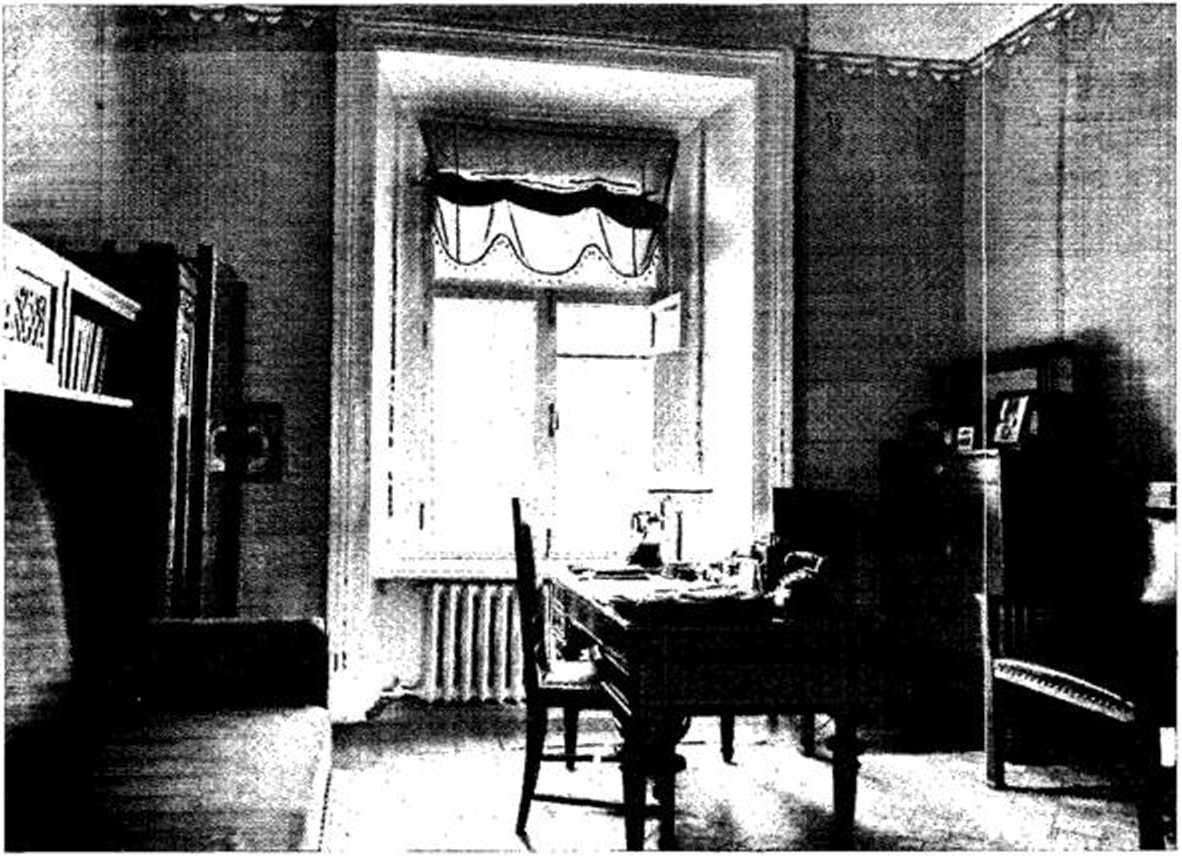5134939265

/. Centralnyi Muzey V. I. Lenina, Mosęu— Branch museum in Razliv. The boat which t<x>k Lenin across Lakę Razliv.
/. Annexe du musće a Razliv. Le canot qu’em-prunta Lenine pour traverser le lac dc Razliv.
Lenin in Moscow. The last few years of Lenin’s life and activity wcrc spent in Moscow. In the Capital and its outskirts there are roughly 150 buildings where Lenin had been at different times.
His Kremlin apartment has also been turned into a memoriał museum (fig. 6y 7). It has three living-rooms and a dining-room. They were occupied by Lenin, his wife—Nadczhda Krupskaya—his younger sister Maria and a woman who helped with the chores. Everything has been preserved as during Lenin’s lifetime. Everything is simple, modest and unassuming.
The V. I. Lenin Memoriał Museum at Gorki. Thirty-five kilometres outside Moscow (fig. <fj, this museum was opened to visitors in 1949. Here Lenin lived for two and a half years between 1918 and 1924. He died there on 21 January 1924.
The rooms are just as they were under Lenin. The exhibits reereate the conditions in which he lived and worked (fig. 9-1 /).
The Lenin museums in the U.S.S.R. are world famous. Annually some 5-6 million Soviet and foreign tourists visit them.
In all the memoriał houses and apartment-museums special measures are taken to preserve and restore the exhibits. When necessary the memoriał sites undergo Capital repairs.
In 1967 the wooden house in Kazan which in 1888-1889 gave shelter to Lenin and his famiły was fully restored (fig. 12). This 80-year old house was in a poor stare. The restoration experts took the house apart, treated the wood with a special Chemical composition to make it fire-resistant, to ensure it against damage by water, and wind, and prevent it from rotting. The foundations have also been reinforced. During its reassembly care was taken not to change the external and intcrnal appearance of the house. A coach-house attached to its side now contains a leeture hall, maintenance rooms and a spacious hall for documentary cxpositions.
What particularly worries the museologists is how to preserve Lenin’s genuine be-longings that are on display at the museums or in storage. It is now possible to say confidently that the special show-cases and containers have successfully solved this problem.
By the joint effort of museologists, research instdtutions and industrial enterprises, a technique has been evolved for the manufacture of a special glass that neutralizes the destructive ultra-violet rays. They have constructed cases filled with inert gas— nitrogen or argon. Special apparatuses have been deyeloped to regulate humidity and temperaturę.
A hermetic chamber on a support of twin glass walls has also been dcyised. The
6. Cabinet i Kavartira V. I. Lenina v. Kremle, Moscu. N. Krupskaya’s room.
6. Chambre dc N. Kroupskala.

216
Wyszukiwarka
Podobne podstrony:
p. Muzey V. I. Lenina, Gorki. The winter gar den p. Le jardin d’hivcr. trouvait une hutte de branche
Heffernan, William Ritual BS excruciating’RM When a woman’s corpse is found behind the Metropoli
skanuj0051 (36) 54 ANDRZEJ KOWALCZYK Ewing R. C., 1989, Industrial museums in Scotland: development
New Forms Taschen 008 One of Frank O. Gehry s morę successful buildings is his Vitra Design Museum i
/. Muzey V. I. Lenina. Oulianovsk. The dining-room whcrc thc family gathered, not only for thci
j. Dom Muzey V. I. Lenina, Chouchenskoic. The house of iJetrova, a peasant voman, where Lenin a
, , . . . S. Muzey V. I. Lenina, Gor
USTREDNI KONTROLNI A ZKUŚEBNI USTAV ZEMEDELSKY Central Institute for Supervising and Testing in
OFFICES >48 24 387 1655 coi@plock.eu www.plock.eu Branch oftlce in Płock 09-402Spiock >48
TURYSTANr. 6 - 7 Le Musee Mieczkowski a Niedźwiedź en Pomeranie. The Miecz kowski - Museum in Niedźw
IMGR51 THE CENTRES OF PRODUCTION (hc Vicnu and Albcn Museum in 1(56 and described u bcing modern* i
the collcction and utilization of technological cxhibits inhomeland museums (in 1957). As far as the
56987 image109 (8) Fig. 97. The rock frora Leźno, presently in Archeological Museum in Gdańsk. Left:
więcej podobnych podstron